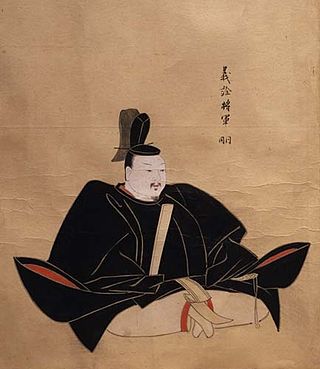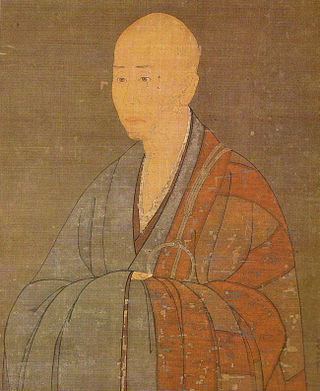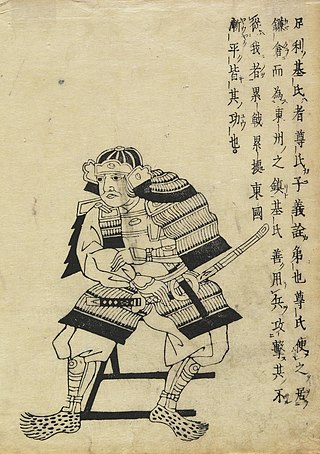Related Research Articles

Nichiren Buddhism, also known as Hokkeshū, is a branch of Mahayana Buddhism based on the teachings of the 13th-century Japanese Buddhist priest Nichiren (1222–1282) and is one of the Kamakura period schools. Its teachings derive from some 300–400 extant letters and treatises either authored by or attributed to Nichiren.

Shogun, officially Sei-i Taishōgun, was the title of the military aristocracy of Japan during most of the period spanning from 1185 to 1868. Nominally appointed by the Emperor, shoguns were usually the de facto rulers of the country, although during part of the Kamakura period, shoguns were themselves figureheads, with real power in the hands of the Shikken of the Hōjō clan.
The 1330s was a decade of the Julian Calendar which began on January 1, 1330, and ended on December 31, 1339.

Emperor Go-Daigo was the 96th emperor of Japan, according to the traditional order of succession. He successfully overthrew the Kamakura shogunate in 1333 and established the short-lived Kenmu Restoration to bring the Imperial House back into power. This was to be the last time the emperor had real power until the Meiji Restoration in 1868. The Kenmu restoration was in turn overthrown by Ashikaga Takauji in 1336, ushering in the Ashikaga shogunate, and split the imperial family into two opposing factions between the Ashikaga backed Northern Court situated in Kyoto and the Southern Court based in Yoshino led by Go-Daigo and his later successors.
The Kamakura shogunate was the feudal military government of Japan during the Kamakura period from 1185 to 1333.

The Muromachi period or Muromachi era, also known as the Ashikaga period or Ashikaga era, is a division of Japanese history running from approximately 1336 to 1573. The period marks the governance of the Muromachi or Ashikaga shogunate, which was officially established in 1338 by the first Muromachi shōgun, Ashikaga Takauji, two years after the brief Kenmu Restoration (1333–1336) of imperial rule was brought to a close. The period ended in 1573 when the 15th and last shogun of this line, Ashikaga Yoshiaki, was driven out of the capital in Kyoto by Oda Nobunaga.

The Kamakura period is a period of Japanese history that marks the governance by the Kamakura shogunate, officially established in 1192 in Kamakura by the first shōgun Minamoto no Yoritomo after the conclusion of the Genpei War, which saw the struggle between the Taira and Minamoto clans. The period is known for the emergence of the samurai, the warrior caste, and for the establishment of feudalism in Japan.

Ashikaga Yoshiakira was the second shōgun of the Ashikaga shogunate who reigned from 1358 to 1367 during the Muromachi period of Japan. Yoshiakira was the son of the founder and first shōgun of the Muromachi shogunate, Ashikaga Takauji. His mother was Akahashi Tōshi (赤橋登子), also known as Hōjō Nariko.

Ashikaga Takauji was the founder and first shōgun of the Ashikaga shogunate. His rule began in 1338, beginning the Muromachi period of Japan, and ended with his death in 1358. Ashikaga Takauji was also known as Minamoto no Takauji (源 尊氏, みなもと たかうじ) of Minamoto clan. He was a male-line descendant of the samurai of the (Minamoto) Seiwa Genji line who had settled in the Ashikaga area of Shimotsuke Province, in present-day Tochigi Prefecture.

The Hōjō clan was a Japanese samurai family who controlled the hereditary title of shikken (regent) of the Kamakura shogunate between 1203 and 1333. Despite the title, in practice the family wielded actual political power in Japan during this period compared to both the Kamakura shoguns, or the Imperial Court in Kyoto, whose authority was largely symbolic. The Hōjō are known for fostering Zen Buddhism and for leading the successful opposition to the Mongol invasions of Japan. Resentment at Hōjō rule eventually culminated in the overthrow of the clan and the establishment of the Ashikaga shogunate.

Prince Moriyoshi was a Japanese prince and monk.

Kenmu (建武) was a Japanese era name of the Northern Court during the Era of Northern and Southern Courts after Shōkei and before Ryakuō. Although Kemmu is understood by the Southern Court as having begun at the same time, the era was construed to have begun after Genkō and before Engen.

Ashikaga Tadayoshi was a general of the Northern and Southern Courts period (1337–92) of Japanese history and a close associate of his elder brother Takauji, the first Muromachi shōgun. Son of Ashikaga Sadauji and Uesugi Kiyoko, daughter of Uesugi Yorishige, the same mother as Takauji, he was a pivotal figure of the chaotic transition period between the Kamakura and Muromachi shogunates. Tadayoshi is today considered a military and administrative genius and the true architect of many of his elder brother's successes. In contemporary chronicles he is rarely called with his name, but is instead called either gosho (御所) or Daikyū-ji-dono (大休寺殿) from the name of his family temple. His posthumous name was Kozan Egen (古山慧源).

Musō Soseki was a Rinzai Zen Buddhist monk and teacher, and a calligraphist, poet and garden designer. The most famous monk of his time, he is also known as Musō Kokushi, an honorific conferred on him by Emperor Go-Daigo. His mother was the daughter of Hōjō Masamura (1264–1268), seventh Shikken (regent) of the Kamakura shogunate.
Hōjō Tokiyuki was a samurai of the Hōjō clan who fought both for and against the Imperial Court. His father was Hōjō Takatoki, last Shogunal Regent and de facto ruler of the Kamakura shogunate.

Chihaya Castle is a late Kamakura period Japanese castle located in the village of Chihayaakasaka, Osaka Prefecture, Japan. Its ruins have been protected as a National Historic Site since 1934.

The Five Mountains and Ten Monasteries System system, more commonly called simply Five Mountain System, was a network of state-sponsored Chan (Zen) Buddhist temples created in China during the Southern Song (1127–1279). The term "mountain" in this context means "temple" or "monastery", and was adopted because many monasteries were built on isolated mountains. The system originated in India and was later adopted also in Japan during the late Kamakura period (1185–1333).

Ryōgonzan Renge-in Myōhō-ji (楞厳山蓮華院妙法寺) is a Buddhist temple of the Nichiren sect in Kamakura, Kanagawa, Japan. It is one of a group of three built near the site in Matsubagayatsu, or the Valley of Pine Needles (松葉ヶ谷), where Nichiren, founder of the Buddhist sect that bears his name, is supposed to have had his hut. The temple has also close ties with Prince Morinaga and the Imperial House.

Emperor Kōgon was the first of the Emperors of Northern Court during the Period of the Northern and Southern Courts in Japan. His reign spanned the years from 1331 through 1333.

Ashikaga Motouji (足利基氏) (1340–1367) was a warrior of the Nanboku-chō period. The fourth son of shōgun Ashikaga Takauji, he was the first of a dynasty of five Kantō kubō, Kamakura-based representatives in the vital Kamakura-fu of Kyoto's Ashikaga regime. Meant to stabilize a volatile situation in the Kantō, a region where many warrior clans wanted the return of the shogunate from Kyoto back to Kamakura, the dynasty he started almost immediately developed the ambition to usurp the shogunate, becoming a serious headache for the central government. Motouji was the only kubō who always remained loyal to the Kyoto government. During the Kannō disturbance, a historical episode with serious repercussions on his life, he tried to reconcile his father with his uncle Ashikaga Tadayoshi and, after his father's demise, he collaborated with his elder brother, shōgun Ashikaga Yoshiakira, to stabilize the shogunate. He died still young during an epidemic.
References
- ↑ Williams, Hywel (2005). Cassell's Chronology of World History . London: Weidenfeld & Nicolson. pp. 159–161. ISBN 0-304-35730-8.
- ↑ Nirenberg, David (1998). Communities of violence: persecution of minorities in the Middle Ages . Princeton: Princeton University Press. p. 18. ISBN 0-691-05889-X.
- ↑ Lock, Peter (2013). The Routledge Companion to the Crusades. Routledge. p. 125. ISBN 9781135131371.